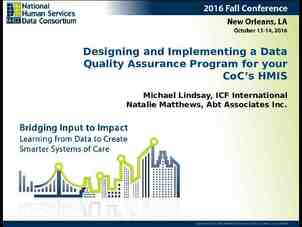QoS Recommendations for VoIP “Yes Voice is different – and yes
15 Slides1.33 MB

QoS Recommendations for VoIP “Yes Voice is different – and yes you need a QoS strategy ” Richard Dominach Director of Business Development and Marketing [email protected] 732 203 9750,x12 www.prominencenet.com February 12, 2003

Voice is Different and Special Voice not just another IP data application Enterprise customers have high expectations: – “No tolerance for poor voice, it has to be toll quality” – “Voice goes down – they are on the phone” – “Don’t want to lose business because of QoS” VoIP Surveys show: Yet Another Data Application – QoS Assurances is #1 concern – CIO Survey – Quality/Reliability is #1 concern – Enterprise Survey – Quality Management is #2 roadblock – Internet Survey Voice inherently different from most data applications – Intolerant of delays, packet loss and jitter – Performance essential to the delivery of the service – Voice specific application behavior

Difficulty of Voice in a Converged Network Traditional Voice Networks – e.g. circuit switching – “Nailed up” circuit per call – Un-shared bandwidth, no “over-booking” – Blocking guarantees QoS for existing calls – “Wrote the book” on quality & reliability Traditional Data Networks – Flexible, open, supports multiple applications – Shared bandwidth - lower costs, but queuing/congestion – Best effort foundation with QoS add-on’s – Real-time Issues: Packet loss, delay/latency, jitter, post dial delay Data Networks must be Voice enabled !!!

Enterprise Convergence Architecture Public Switched Telephone Network (PSTN) Media Server IP Phones IP PBX PSTN Gateway T1 Access Trunks Analog Phones Traditional PBX CONVERGED IP SERVICES NETWORK Applications Video Fax Servers Clients IP Phones Video IP Phones

Today’s Multi-Application Converged Network Challenges Operations Center Application Endpoints: Voice, Video, Applications, Servers Complex and manually driven No visibility into services/applications and QoS performance Statically defined traffic engineering and routing Reactive PSTN Reliable but costly Fall-back when IP network gets busy Legacy PBX IP PBX SD 1 2 3 4 C T R I LI OK NG TEST ACT ALM PWR LINE AL M 1 21 23 1 2 3 45 CLK MODE R ATE AC/DC TEST 1234 L INE MODE LAN Switch OFF ON 2 .0A 2 .0A AC PWR ON DC OFF Mission Critical Applications IP Network Strict QoS performance requirements Network contention occurs due to lack of service-aware, end-to-end path control Dynamic, complex, any-to-any routing No visibility into real-time service and how to optimize, control, and manage QoS routes and bandwidth Per-hop orientation - subject to congestion points and bottlenecks Complex to traffic engineer and maintain

The Hidden Costs of Convergence WAN Over-provisioning Negative IP Telephony Business Case LAN Over-provisioning Increased administrative costs Extensive Troubleshooting Unintended PSTN usage Monitoring and measurement Problems grow as network size increases Positive IP Telephony Business Case Hidden Costs of Convergence

Voice QoS Methods and Techniques Good Intentions Procrastination Avoidance Over-confidence Hope Luck Prayer Excuses Over-provisioning Monitoring and Measurement Call Access Control & PSTN Fallback Differentiated Services based approaches Integrated Services based approaches

Over-Provisioning – “Bursty” Traffic – 3X to 5X not sufficient – Congestion still occurs Packet Counts 5000 4500 4000 3500 3000 Packets Traditional approach for data networks No mechanism for QoS Is actually best-effort 5x Overprovision where? 4x 3x Expensive Converged Networks: 2x Bandwidth Over-Provisioning Mean 2500 2000 1500 1000 500 0 0 1 2 Hours 3 4

Monitoring and Measurement Provides information to understand, manage and troubleshoot voice traffic and network status Multiple methods and approaches: – – – – Equipment, Software, Hardware Real-time vs Historical Simulated vs Actual traffic Network vs Service View Voice-centric performance measurements Recognizes when a problem occurs, but typically doesn’t correct or fix the problem An important tool to help engineer QoS; but use it proactively, not reactively

Call Access Control & PSTN Fallback Every network can support a fixed level of traffic Circuit switch network blocks calls to maintain QoS Call Admission Control – Recognizes when network resources are not available – Blocks calls to maintain quality of existing calls and to prevent congestion – Local vs Global Call Access Control Strategies – Conservative vs Aggressive Strategies PSTN Fall-back – “Fall-back” to the PSTN when IP network is congested – Maintains quality but increases PSTN costs

Differentiated Services (DiffServ) Predominant QoS technology in use today Bandwidth allocated per traffic classes (via DSCP) Traffic Classification and Conditioning at edge Per Hop Behavior at interior nodes – Queuing and Dropping according to priority & bandwidth Queuing must be configured for minimum packet delay Easy for endpoints, scales well, CPU intensive DiffServ: – – – – – Has no end-to-end network/service view No Call Admission Control Scheme High priority packets can be dropped when congested Often difficult to configure and maintain Doesn’t guarantee high quality

Integrated Services (IntServ) Reserves resources end-to-end to provide service guarantees Uses the RSVP protocol which signals per flow QoS requirements to the network If reservation succeeds, flow has end-to-end guaranteed bandwidth Includes an inherent call admission control mechanism Ideal for real-time traffic such as voice and video Providing benefits similar to circuit switching Not as heavily used due to perceived drawbacks: – Setup times, I.e. post-dial delay – Scalability due to per-flow RSVP – Amount of state information and overhead

QoS Strategies and Recommendations I Over-provisioning: – Don’t make this the foundation of your QoS strategy !!! – Unless you have very deep pockets !!! Monitoring and Measurement: – – – – Avoid “Information Overload” Insist on Voice Specific Performance reporting Keep it actionable, pro-active and responsive Integrate your M&M into your QoS strategy Call Admission Control – An essential capability whether IntServ or DiffServ based

QoS Strategies and Recommendations II DiffServ – Consider automated support for configuration/maintenance – Must be carefully engineered to minimize packet loss – Call Admission Control mechanisms essential IntServ – Most powerful technique; guarantees end-to-end service quality – New Aggregated Reservation technology overcomes limitations Scalable, fast setup, low overhead, easy to manage Conclusion: – No traditional QoS method provides guaranteed service quality – Existing techniques have strengths and weaknesses – Effective QoS strategy dependent on leveraging the appropriate QoS tools for your environment and needs

The Benefits and ROI from QoS Operations Center Operations Savings Fewer PSTN Trunks PSTN Reduced ISDN Minutes Legacy PBX Reduced PSTN Minutes IP PBX Enterprise WAN Network WAN Bandwidth Savings Access Bandwidth Savings






